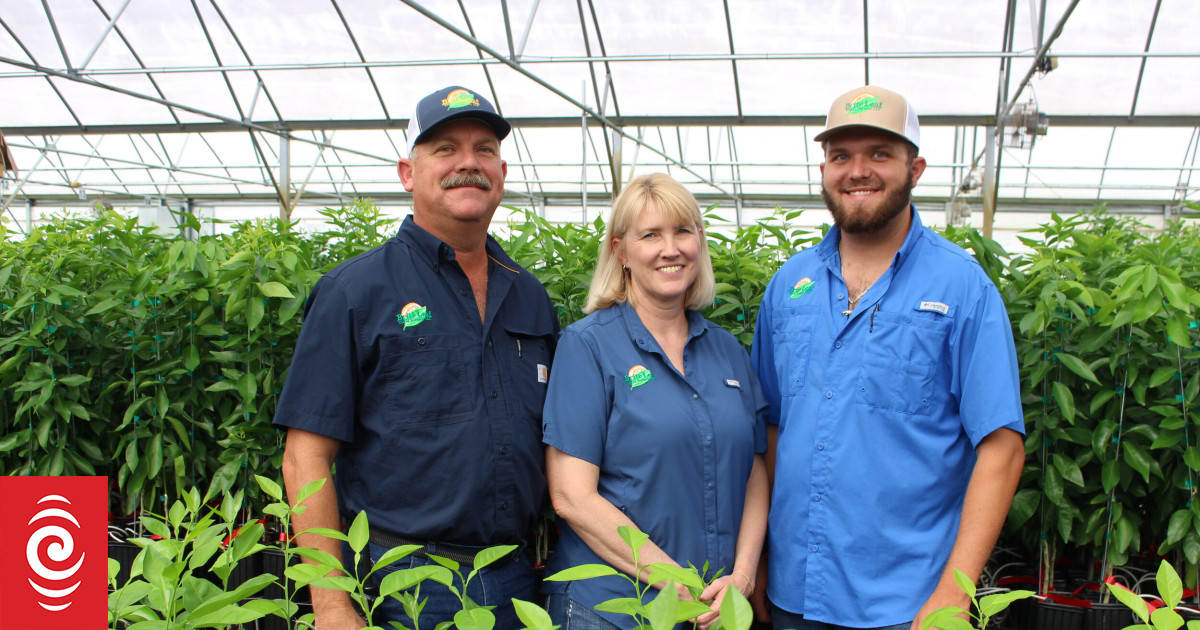
Nate, Anna and their son Nathan Jameson at their Brite Leaf Citrus Nursery at Lake Panasoffkee in Florida before the citrus greening disease incursion.
Photo: SUPPLIED
American citrus growers are warning New Zealand growers that a plant disease infestation can be a “catastrophe” as it was for them in Florida – and disease prevention is key.
Nate and Anne Jameson were recounting their experiences with citrus greening disease in Tai Rāwhiti at industry group Citrus New Zealand’s conference on Wednesday.
The Jamesons grew a range of citrus fruit and have run a large indoor citrus operation Brite Leaf Nursery for about 26 years at Lake Panasoffkee near Tampa in central Florida – selling to both commercial and backyard customers.
But the pair’s nursery has been hit by citrus greening disease in recent years, a bacterial disease transmitted by Asian and African citrus psyllids.
The United States Department of Agriculture said the untreatable citrus greening disease was first detected in Florida in 2005.
The citrus psyllids feed on the stem of the citrus plant, infecting the tree with bacteria which goes underground into the root system and multiplies – killing infected trees within a few years of infection.
Leaves became yellow, asymmetrical and mottled on infected trees, and fruit was often irregularly shaped, smaller, harder and bitter-tasting – and there was no cure for the plant disease.
It spread across the state, killing trees and devastating orchards, reducing Florida’s citrus production by 75 percent – then spreading west to Louisiana, Texas and California.
Nate Jameson said the destructive disease was likely imported into the US state, but local authorities were too slow to respond and it spread very rapidly.
“I think the mistake that we made in Florida is we were not aggressive enough in trying to prevent disease from entering the country,” Jameson said.
“We sat on our laurels; we got used to the idea that we haven’t had a problem, so why should we deal with the problem?
“I think one of the messages I would like for growers in New Zealand to understand is it prevention is cheaper than reaction.”
Jameson said it was very difficult to convince both Governments and grower organisations to spend money on plant disease prevention measures – like keeping the insect at bay through netting and widescale weeding – for a problem that had not yet eventuated.
“I admit that’s a huge challenge,” Jameson said.
“At the same time, the citrus industry in Florida was an US$8 billion industry. It’s now less than about US$2 billion and shrinking fast.
“In 1989, the state of Florida had about 863,000 acres of citrus. Today in Florida, we’re down to about 200,000 acres of citrus.”
Jameson said Florida lost the majority of its orange and citrus production, many packing sheds shut down and employees left the area as work dropped off.
He said the incursion had a “significant” financial impact on their family-owned business.
“The reality is if you get the right combination of insects and disease, you have the recipe for a potential – I want to be careful how I say it – catastrophe, which is what we have in Florida.”
Nate Jameson commended New Zealand’s strong biosecurity measures, like the fruit boxes at airport borders, which he said did not exist in Florida.
He and Anna Jameson were now investigating other more viable crops when they return home.
Citrus New Zealand said there were no cases of citrus greening disease in New Zealand.

